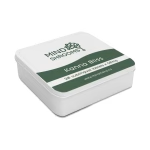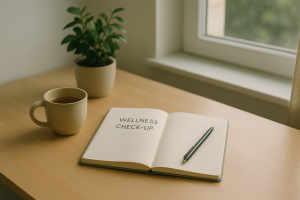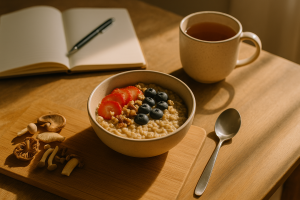In the wellness world, we often talk about supplements, rituals, and new routines — but sometimes, the most transformative changes are also the most grounded. One of those is this: eating mushrooms regularly.
Mushrooms are not a superfood trend or a niche ingredient. They are versatile, nutrient-rich, sustainable, and delicious. And most importantly, they can easily become a daily part of your wellness routine — through food, not pills.
From their impressive nutritional profile to their ability to support digestion, focus, and energy, mushrooms offer holistic support that integrates beautifully into modern lifestyles. This article explores how — and why — to bring more mushrooms into your diet, no matter your cooking skill level, dietary pattern, or schedule.
Why Mushrooms Deserve a Daily Spot on Your Plate
Mushrooms are the quiet achievers of the wellness world. They don’t make bold claims. They don’t overpower flavors. But beneath their earthy texture lies a powerful blend of nutrients and compounds:
Low in calories and fat, but rich in fiber, B vitamins, potassium, and antioxidants.
Contain beta-glucans, which support immune function and gut health.
Some (like Reishi or Lion’s Mane) offer functional benefits when consumed consistently over time.
Naturally umami-rich, making them a flavor enhancer that can reduce the need for excess salt or meat.
In short: they’re good for your body, good for your mind, and good for your taste buds.
How to Start: Choosing the Right Mushrooms
There are dozens of edible mushrooms available, but these are the most accessible and effective for daily use:
Mushroom | Texture & Flavor | Ideal For |
|---|---|---|
White Button | Mild, soft when cooked | Omelets, pasta, stir-fries |
Cremini | Earthier than white button | Soups, roasted dishes |
Portobello | Meaty, dense | Grilled mains, burger substitute |
Shiitake | Umami-rich, chewy | Broths, noodles, sautés |
Oyster | Delicate, slightly sweet | Quick stir-fries, grain bowls |
Maitake | Crispy when roasted | Toppings, savory bakes |
Enoki | Crisp, stringy | Salads, soups |
You don’t need to memorize their nutritional differences to benefit — variety alone introduces a wider range of nutrients, textures, and bioactive compounds.
Everyday Ways to Eat More Mushrooms
Let’s break down how to bring mushrooms into each part of your day.
🌄 Breakfast: Start Light and Savory
Mushroom & spinach omelet: Lightly sautéed cremini or shiitake with greens.
Avocado toast with roasted mushrooms: Top with thyme and sesame seeds.
Savory oatmeal: Add sautéed oyster mushrooms, a dash of miso, and scallions.
Tip: Pre-sauté mushrooms on Sundays and store in the fridge. They reheat beautifully and make weekday breakfasts effortless.
🌞 Lunch: Balanced Bowls and Boosted Salads
Grain bowl with roasted maitake or portobello: Add lentils, greens, and a lemon-tahini dressing.
Hearty miso soup: Add shiitake and enoki mushrooms for texture and depth.
Wraps or sandwiches: Use grilled mushrooms as the central filling instead of meat.
Tip: Marinate mushrooms in olive oil, balsamic, and herbs for 30 minutes before cooking — enhances flavor and softens texture.
🌙 Dinner: Comfort Meets Function
Pasta with mushroom ragù: Cremini, shiitake, and garlic slow-cooked with tomatoes.
Mushroom stir-fry: Combine with bok choy, tofu, and sesame oil for a quick, balanced meal.
Baked sweet potatoes with mushroom stuffing: Use a mix of oyster and maitake for a crispy, nourishing topping.
Tip: Add dried mushrooms to soups and stews for a deeper flavor — and extra beta-glucans.
🍵 Broths and Teas: Ancient Wisdom, Modern Ease
Even beyond solid meals, mushrooms can be integrated into liquid rituals.
Mushroom broth: Simmer shiitake, garlic, ginger, and onion skins for an hour. Drink as is or use as soup base.
Reishi tea: Brew dried Reishi slices with cinnamon and orange peel for a calming evening drink.
Tip: Strain and store broth in jars for the week. Sip warm during work for an afternoon reset.
Making Mushrooms a Weekly Habit
To build consistency, here’s a simple plan you can start this week:
Day | Meal | Mushroom Use |
|---|---|---|
Monday | Breakfast | Sautéed mushrooms on toast |
Tuesday | Lunch | Grain bowl with roasted maitake |
Wednesday | Dinner | Pasta with mushroom ragù |
Thursday | Snack/Tea | Reishi or Shiitake broth |
Friday | Lunch | Salad with grilled portobello |
Saturday | Brunch | Omelet with shiitake and herbs |
Sunday | Dinner | Stir-fry with mixed mushrooms |
You don’t need a new mushroom dish every day — just a rotation of simple, repeatable favorites.
Common Myths About Eating Mushrooms
Let’s clear up a few things:
❌ “Aren’t mushrooms mostly water?”
Yes, they’re about 90% water — but that doesn’t mean they’re nutritionally void. The remaining 10% is packed with bioactive compounds, fiber, and micronutrients.
❌ “I don’t like the texture.”
Try different species. Oyster mushrooms are tender, maitake gets crispy when roasted, and enoki offers a crunchy bite. Preparation method matters more than you think.
❌ “They’re too expensive to eat daily.”
White button and cremini mushrooms are affordable, especially when bought loose or in bulk. Dried mushrooms last for months and expand when soaked — offering great value.
Cooking Tips for Flavor and Nutrition
Don’t crowd the pan: Mushrooms release water. Cook in batches for the best browning.
Use medium-high heat: This enhances flavor and texture.
Add salt at the end: Helps prevent excess moisture early on.
Store in paper bags: They stay fresh longer than in plastic.
Want more flavor? Add soy sauce, miso, or lemon juice at the end of cooking — acids and umami boost mushroom depth without added fat.
A Mindful Approach to Eating Mushrooms
Eating mushrooms daily isn’t just about nutrients — it can also be a grounding, sensory ritual.
Notice their shape and color as you chop.
Smell the earthy aroma as they cook.
Chew slowly, appreciating the texture and umami.
Pair with herbs, spices, and whole foods that honor the simplicity of what mushrooms offer.
In a world of complicated health routines, mushrooms invite ease, tradition, and connection to the earth.
Final Thoughts: Wellness You Can Taste
You don’t need powders, capsules, or trends to start feeling better — sometimes, all it takes is a pan of mushrooms, a little heat, and your own intention to nourish.
Whether you’re roasting maitake on a Sunday or sipping shiitake broth between Zoom calls, each mushroom you eat is a vote for your long-term vitality — and a small, beautiful act of care.
So buy a handful this week. Try one new recipe. Build the habit slowly, naturally, and deliciously.
Because wellness should taste good, too.







